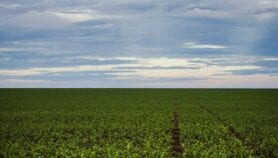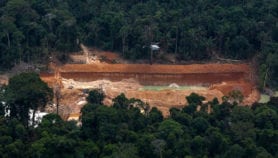By: Siwa Msangi
Send to a friend
The details you provide on this page will not be used to send unsolicited email, and will not be sold to a 3rd party. See privacy policy.
Strong international policies are needed to stop the biofuel revolution threatening food security for the poor, says Siwa Msangi.
Countries are shifting to biofuels in response to climate change and rising oil prices. But biofuel production poses new food security risks and challenges for poor people. Higher food prices, subsidies for biofuels, and environmental degradation will all be felt disproportionately by the developing world. So while developing and using biofuels is high on the global political agenda, policymakers, researchers and others must carefully assess the consequences for the poorest of the poor.
Biofuels increase food prices
Global ethanol fuel production — over 90 per cent of total biofuel production — more than doubled between 2000 and 2005. Global biodiesel production nearly quadrupled in the same period. This tremendous rise is already adversely affecting poor people in developing countries by increasing food prices and their volatility.
Producing biofuel source material, such as corn and sugarcane, accounts for most of biofuel production costs. Increases in source costs by at least 50 per cent over the past few years have harmed the comparative advantage and competitiveness of individual countries. While growth within the biofuel sector can contribute to increases in the price of corn and other biofuel source material, the competitiveness of the sector can be adversely affected by these very same prices changes, as well as other economic factors.
Both agricultural commodity and energy prices have increased significantly in recent years. In the past there was no significant correlation between them, but since 2002 the correlation has strengthened. And the use of cereals for industrial purposes — including for biofuel production — has increased by more than 25 per cent since 2000. These emerging trends suggest that food and energy markets are likely to be more strongly linked in future – such that spikes and fluctuations in the prices of energy lead to corresponding changes in food prices.
Looking ahead to 2020
Using state-of-the-art computer modelling, the International Food Policy Research Institute (IFPRI) has projected prices of biofuels for two potential scenarios up to the year 2020. Scenario one is based on current biofuel investment plans, and predicts that the international price of maize and oilseed will increase by 26 per cent and 18 per cent respectively. Scenario two assumes double the expansion of biofuels in scenario one, and suggests a price increase of 72 per cent for corn and 44 per cent for oilseeds.
In both scenarios, increasing crop prices go hand in hand with decreasing availability of, and access to, food. Poor people spend a much bigger share of their budgets on food than they do on energy, about 50–70 per cent on food and 1–10 per cent on energy. With high prices, they will likely spend less on food, exacerbating poor diets and micronutrient malnutrition.
The scenarios estimate that calorie consumption will decrease across whole regions, compared to baseline levels. Consumption decreases the most in Sub-Saharan Africa, where scenario two projects that food availability could fall by more than eight per cent by 2020.
The scenario results suggest that a variety of changes on the supply side (including droughts and diverting food for fuel) can powerfully push up food prices. Demand for food is already strong because incomes are growing fast in some developing countries. If this situation continues, food prices will likely stay high for quite some time even without further supply shocks.
Policy issues
Comprehensive international and national policy frameworks can lay the foundation for pro-poor environmentally sustainable biofuels that also achieve energy security. We need policies that accelerate agricultural productivity, helping to maintain and improve food security, and which focus more on agricultural and biofuel technologies in coordination with biofuel users. Trade and market reforms must establish a global system for biofuels that is undistorted and operates with low transactions costs.
In general, biofuels that use food sources are costly to the poor and raise prices on the basic foods that already represent a large share of poor people’s household spending. Therefore, the crop subsidies that encourage the production of biofuels from certain food sources have a welfare burden on the poor, as well as on producers of those crops in other countries. But in certain cases the benefit to society at large of reducing carbon emissions might justify some level of producer support and price policy towards biofuels, since simple market forces do not recognize such benefits, and fail to reflect them in market prices. If this were so, then the cost of fossil-based fuels would be much higher, as a reflection of their true impact on the environment.
The environmental impacts of biofuel production, such as levelling forests to plant biofuel crops and declining soil fertility, can be managed in sustainable or in damaging ways. Policies should take into account biofuel’s positive and negative effects to help ensure we don’t use more energy producing them than they actually provide.
Biofuels that don’t use food as their source, such as converting cellulose to liquid fuels, can utilise waste biomass and use less land resources. But these second- and third-generation technologies are still being developed. Future technological advances may make them competitive on a large-scale, but will not solve the food–fuel competition problem entirely because some of those cellulose-rich materials are used for animal feed or for enriching the fertility of agricultural land after harvest – thereby creating a trade-off with livestock and land productivity.
Furthermore, as biofuels from cellulose-rich crops become increasingly profitable, more land, water and capital will be diverted to produce them, and some parts of the world might still face a trade-off between using those resources for the production of calorie and nutrient-rich food crops, or for the cultivation of cellulose-rich fuel crops. Some scientists see this as a challenge to develop crop breeds that can provide both – thereby supplying energy for both humans and the machines they depend on.
Perhaps most importantly, since large-scale food and nutrition insecurity already exists, and will likely be exacerbated by on-going and future changes in climatic conditions, the focus of national governments and partnering international agencies should remain on increasing the productivity and resilience of agricultural production and food systems.
The increasing demand for biofuels will inevitably place added strain on these agricultural production and food delivery systems, as long as biofuel production remains largely dependent on food crops for source material. Technological innovations within the biofuels industry will ultimately reduce this dependence, but in the meantime policymakers must provide added incentives towards innovation and social protection for those most at risk — the food-insecure poor.
Siwa Msangi is a research fellow at the International Food Policy Research Institute (IFPRI). IFPRI seeks sustainable solutions to hunger and poverty. It is one of 15 centres supported by the Consultative Group on International Agricultural Research, an alliance of 64 governments, private foundations, and international and regional organisations. IFPRI’s website is at www.ifpri.org.
See Letter to the editor.
See Letter to the editor.
This article is part of a Spotlight on The biofuels revolution.













